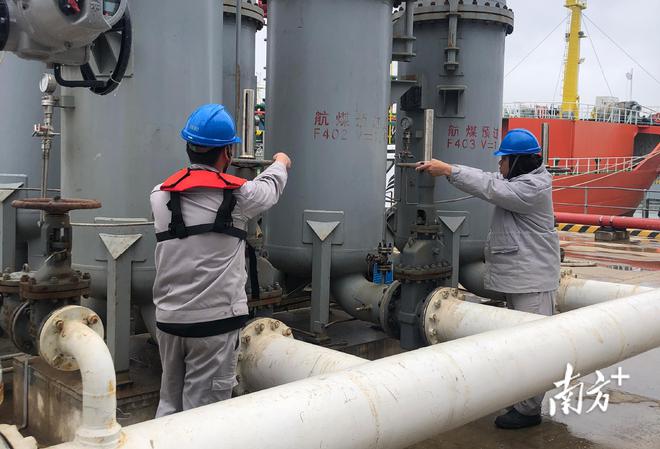PetroChina Guangdong's First SAF Products Shipped Out
From:
Zhonglin International Group Date:04-27 1777 Belong to:Industry Related

At 3:20 pm on April 2nd, the "Changli 16" oil tanker, carrying 9900 tons of high-quality aviation kerosene, departed from the product terminal of Guangdong Petrochemical Company located in Jieyang City, Guangdong Province, and headed towards the Yangpu Comprehensive Bonded Zone in Hainan. This is the first ship of aviation kerosene produced by Guangdong Petrochemical Company and also the first batch of finished oil products exported by the company.
It is understood that Guangdong Petrochemical Company has three units capable of producing aviation kerosene, including a 1.2 million ton/year aviation coal hydrogenation unit, a 3.7 million ton/year hydrocracking unit, and a 3.3 million ton/year diesel hydrogenation unit II. The 1.2 million tons/year aviation coal hydrogenation unit is the main force in the production of aviation coal. The device has introduced Shell's enhanced aromatics saturation deep hydrogenation treatment technology. Construction began in April 2020 and was successfully started in December of that year, with an operating pressure of 7.7 megapascals. It is the highest operating pressure aviation coal hydrogenation device in China.
The catalysts used in the device directly affect the performance of aviation coal products. After multiple rounds of in-depth and comprehensive technical exchanges and the organization of professional research teams to overcome bottlenecks, Guangdong Petrochemical Company, China Petrochemical Research Institute, and Fushun Petrochemical Company Catalyst Plant have jointly developed a low-quality kerosene hydrogenation catalyst PHK-102 with deep desulfurization and aromatic saturation performance, meeting the required standards and stability of the product, The complete replacement of domestic catalysts plays an important role in promoting the high-quality development of Guangdong Petrochemical, and also provides reliable technical support for China Petroleum to ensure the supply of aviation fuel in China.
The China Petroleum Guangdong Petrochemical Refining and Chemical Integration Project is a key project that deeply implements the national strategy of the Guangdong Hong Kong Macao Greater Bay Area and improves the overall layout of China Petroleum Corporation. In 2023, it plans to process 15 million tons of crude oil, achieve a total product volume of 12 million tons, and produce oil and chemical products that will cover the markets of southern China, Hong Kong Special Administrative Region, and overseas markets such as Singapore.
There is a high correlation between the demand for aviation kerosene market and the prosperity of the civil aviation industry. With the end of the global epidemic and the continuous recovery of the civil aviation transportation industry, it will provide strong support for the demand space of the aviation kerosene industry. In recent years, global attention to environmental protection and sustainable development has been increasing. Countries are actively achieving carbon peaking, carbon neutrality, and creating a low-carbon clean energy world. The aviation industry is one of the industries that is difficult to reduce emissions. The global aviation industry has proposed the goal of achieving net zero emissions by 2050. To achieve this goal, in addition to developing new aircraft technologies and improving operational and infrastructure efficiency, The development of sustainable aviation fuel (SAF) will be the most important measure to achieve the net zero target. By 2050, 65% of emissions reduction will be achieved through the use of SAF.
As a low-carbon alternative to traditional aviation fuel, SAF is mainly synthesized from waste oil, agricultural and forestry waste, urban waste, non food crops, or processed from green electricity and carbon dioxide, and is therefore considered a sustainable aviation fuel. Faced with the urgent need to address climate change, green carbon has become a global consensus. At present, the global aviation industry still faces significant challenges in carbon reduction. According to the prediction of the International Civil Aviation Organization (ICAO), with the continuous development of the aviation industry, without additional emission reduction efforts, the cumulative carbon dioxide emissions generated by international aviation business alone between 2020 and 2050 will account for 7% of the total global emissions during the same period.
Among the many emission reduction measures in the aviation industry, the emission reduction potential generated by optimizing conventional technologies such as innovative aircraft technology and improving operational and infrastructure efficiency is relatively limited. Electric and hydrogen powered aircraft still require further technological development. Therefore, the application of SAF is widely regarded as the most promising carbon reduction measure in the industry. This requires the global aviation industry to use SAF on a larger scale to replace traditional aviation fuel. According to IATA's estimation, in order to fully leverage the emission reduction effect of SAF, its application volume needs to increase significantly from 63 million liters (about 50000 tons) in 2020 to nearly 7.9 billion liters (about 6.3 million tons) in 2025, and then to 449 billion liters (about 358.3 million tons) in 2050.
At present, the research, production, and application of SAF are mainly concentrated in European and American countries, and the development path shows significant policy driven characteristics. Due to the higher application cost of SAF compared to traditional aviation fuels, whether there is a mandatory or recommended SAF blending ratio is the most important factor affecting consumer demand. Overall, the Chinese SAF industry faces both opportunities and challenges. There are still certain obstacles in China's SAF industry in terms of production capacity, technology, raw material supply, and cost. The wide distribution and large availability of SAF raw materials provide a guarantee for the supply of SAF, but high collection and processing costs, as well as a single technological route, also limit the development of the industry to a certain extent.
In the past two years, with the continuous evolution of technology, the SAF industry is about to experience an explosion. The research team of the Department of Chemical Engineering at Tsinghua University has successively published research results in ACS Catalysis and Nature Communications, marking significant progress in the field of CO2 to Aviation Fuel (CO2AFTM) production by the research team. By designing a process route targeting aromatic aviation coal fractions (C8-C15) as the target product, a spontaneous reaction pathway for CO2 hydrogenation can be achieved thermodynamically; The hydrogenation ability of CO ₂ was increased by three times using metal oxide molecular sieve catalysts. This technology can synthesize bio aviation kerosene from carbon monoxide, carbon dioxide, and hydrogen obtained from biomass gasification in a one-step process; Alternatively, using captured carbon dioxide as raw material, green aviation kerosene can be synthesized by hydrogenation of carbon dioxide. The Key Laboratory of Low Carbon Conversion Science and Engineering of the Chinese Academy of Sciences has made new progress in the synthesis of carbon neutral aviation fuel with new cobalt iron alloy catalytic materials. The research findings were published online under the title "Direct conversion of CO2 to a jet fuel over CoFe alloy catalysts" in The Innovation (2021, 2 (4), 100170) under Cell Press. The team designed and synthesized a novel catalytic material (CoFe) of cobalt iron alloy modified with sodium (Na) additives, successfully achieving the relay, functional matching, and optimization of reverse water gas shift (RWGS) reaction and Fischer Tropsch synthesis reaction (FTS). Under mild conditions (240 ℃, 3 MPa), CO2 hydrogenation was directly converted into aviation fuel, and the selectivity of C8-C16 reached 63.5%, breaking the ASF limitation of traditional FTS with the highest theoretical selectivity of only 41% for C8-C16, which is currently the highest value reported in literature. In addition, the catalyst showed good catalytic stability within a 120 hour uation time and has good industrial application prospects.
On different tracks of synthesizing SAF technology, the use of green electricity and capturing carbon dioxide to synthesize aviation kerosene will be the most important and promising development path in the future, including photothermal power generation. Following the technological path of "photovoltaic/wind power/photothermal power generation → electrolysis of water for hydrogen production → capture of carbon dioxide → synthesis of aviation kerosene". Similar to the coastal aviation oil production base in Jieyang, in addition to facilitating the export of SAF to the world by sea, green hydrogen can also be imported through ports, further reducing production costs.
With the promotion of carbon reduction in the aviation industry, there is potential for rapid growth on both the supply and demand sides of SAF under potential policy guidance and support in the future. From a theoretical production capacity perspective, if the existing and planned hydrogenated biodiesel (HVO) production capacity in China is expanded to prepare SAF, combined with the existing SAF production capacity, it is expected that the total potential production capacity of SAF in China will reach 2.05 million tons/year by 2025, and the supply can meet 4.5% of China's total aviation fuel demand that year.
Promoting the development of SAF has positive significance for China's circular economy and energy transformation. The raw materials for preparing SAF are mostly waste, and the development of the SAF industry will effectively promote waste recycling and reduce environmental pollution. Currently, if favorable internal and external conditions can be fully utilized, policy directions can be further clarified, technology research and promotion can be increased, and the emission reduction potential of SAF can be unleashed, SAF will play an important role in reducing carbon emissions in China's aviation industry, achieving carbon peak and carbon neutrality goals, and enhancing energy security.



